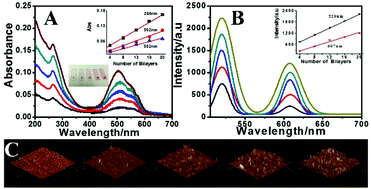A dual-signal sensing system based on organic dyes-LDHs film for fluorescence detection of cysteine†
Abstract
It is of great significance to sense cysteine (Cys) in a simple and fast way because of its potential applications in biological processes. In this contribution, we proposed a Cu2+-mediated fluorescence switchable strategy to detect Cys by designing a dual-signal fluorescence-enhanced sensor. Two organic dyes immobilized onto layered double hydroxides (LDHs) as novel sensors have been fabricated. It was found that the two fluorescence emissions of the obtained ultrathin films (donated as calcein@NFR/LDHs UTFs) could be effectively quenched by Cu2+ (off state), then reversibly recovered by Cys (on state) owing to the specific coordination of Cys and Cu2+. Under the optimal conditions, there were good linear relationships between the off–on efficiency (off–on) and the amount of Cys in the range of 1.0 × 10−7–1.2 × 10−6 M, with lower detection limits of 5.0 × 10−8 M at 520 nm and 2.3 × 10−8 M at 607 nm, respectively. There is little interference by common ions, amino acids and some excipients. The dual-signal fluorescence-enhanced response of the sensor contributes to its high sensitivity and selectivity. The proposed strategy is label-free, fast and selective, which is applicable to the analysis of Cys in medicine with satisfactory results.


 Please wait while we load your content...
Please wait while we load your content...